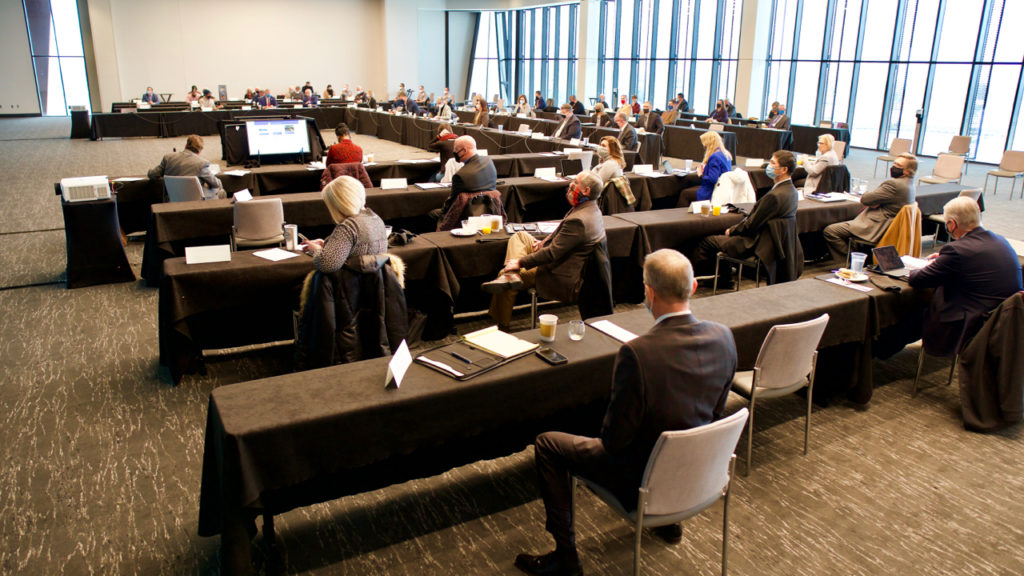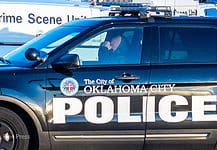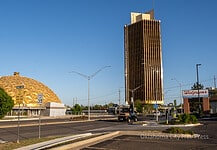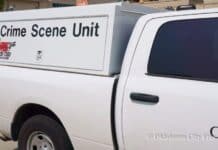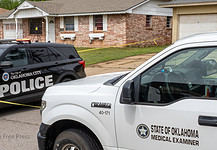Last Updated on February 9, 2021, 8:17 PM | Published: February 9, 2021
OKLAHOMA CITY — Tuesday, the City Council and the City’s department heads and union representatives met for the annual Budget Workshop.
The assembly heard from City Manager Craig Freeman, Finance Director Brent Bryant, and Budget Director Doug Dowler.
Economist Dr. Russell Evans who has been resourcing the budget workshop for several years delivered his five-year financial outlook for Oklahoma City concluding that it is one of cautious optimism.
Trend Indicators
The first presentation for the workshop came from Bryant, who talked about the 22 indicators of trends for Fiscal Year 2021. These indicators came with scores of positive, neutral, and negative.
External indicators track conditions and demographics that give insight into the broader environment in which the City government exists. Among the positive trends in external indicators, Bryant listed population, labor force, average weekly earnings, crime rate, and property value.
Among the negative trends for external indicators mostly seem to reflect the pandemic that has now ravaged the country for almost a whole year. Those include office vacancy rate, airport activity, hotel room nights sold. The list also included active oil drilling in the state, which has decreased.
Internal indicators are those that track the City’s budgetary and financial condition.
Revenue per capita has shown a positive trend. Revenue accuracy, which is General Fund collections compared to the budget, has shown a negative trend. Sales tax and use tax have shown a positive trend, whereas those taxes as a percentage of the General Fund are on a neutral trend.
Hotel tax revenue has, unsurprisingly, been trending negatively, as has grant revenue as a percentage of total operating revenue.
The ratio of City employees to citizens continues on a positive trend, with the number being approximately 7 employees per 1,000 citizens. It is unclear if the term “citizen” used by the city in this case refers to residents, as Mayor Holt has argued in the past, or native and naturalized citizens.
Fringe benefits for those employees is on a neutral trend, as is pension funding.
Bryant said that long-term debt is on a neutral trend. That reflects a ratio of General Obligation Bonded Debt to the Net Taxable Assessed Value.
Fund balance (as a percentage of the General Fund budget), liquidity, and enterprise working capital have all been on a positive trend.
Bryant specified that indicators the City officials need to continue to monitor are drilling activity, office vacancy, airport activity, hotel room nights sold, hotel tax revenue, grant revenue, and fringe benefits.
Again, it was pointed out, that if vaccination rates rise and our community sees a significant decrease in COVID cases, many of those indicators should improve.
Economic Outlook
Dr. Russell Evans, economist from the Meinders School of Business, an outside contractor for the City, came to give a presentation for again this year on the economic outlook for Oklahoma City.
The theme of Evans’ presentation was “An Uncertain Exit Ramp.”
He presented three key uncertainties about that outlook. He asked if we are really on an exit ramp to a post-pandemic economy. Evans thinks so. However, he said, the length of the exit ramp is uncertain, but definitely will not be short. He also said that we should not expect that exit to be very smooth for everybody.
Some of the outlook data is clouded by the fact that production and sale of goods in Oklahoma have declined significantly over the past year through the pandemic. However, personal incomes have increased slightly. The increase owes to federal relief money such as PPP loans, direct relief payments, and federal unemployment payments.
5-YR-Forecast-City-Council-Workshop-For-WebEvans said that the numbers for income and for production will have to “get right with each other.” Incomes rising without a commensurate increase in production causes inflation in our current economic system.
Evans also explained that our current unemployment rate in central Oklahoma can be a bit misleading. Oklahoma City currently enjoys an approximate 95% employment rate, which many economists consider “full employment.” However, the questions asked to collect that data do not account for the hotel worker who hasn’t worked in a couple of months but has a job waiting for them “when things get back to normal.” That person is considered employed.
Contrarily, persons who have been unemployed are only counted as such if they are still actively looking for a job. Otherwise they are considered to have left the workforce. That would include people who have lost hope, or who have simply become stay-at-home caregivers during the pandemic as their children are out of school.
Evans left the group with some assurances that things appear to be on track to get back to a potentially pre-pandemic economy, but that there is no fast track back to that point. Some people, it seems, will struggle more than others.
Evans said that economic policy is like a blunt instrument. To help individuals slipping through the cracks of the crisis, policy needs to be more surgical.
Five-year forecast
Budget Director Doug Dowler gave a presentation on the Five-Year Forecast for the City’s budget.
He started by pointing out some good outcomes the City has seen. Those include terminal expansion at Will Rogers Airport, the adoption of a new agenda and meeting software that has made the meeting process more smooth (for most City Councilors), and an increase in resident satisfaction with road conditions in Oklahoma City. It must be noted that the increase in resident satisfaction doubled, but only from 9% to 18%. Dowler said that there is obvious room for improvement.
Dowler went on to point out concerns that the City should pay attention to over the coming five years, as they relate to our budget. He listed eight.
(1) The First Americans Museum is expected to open in September 2021. The City will be responsible for the operations and maintenance of the facility. The City is in partnership with the Chickasaw Nation through the AICCM Land Development, LLC to develop commercial property around the museum.
(2)Long term water capital will be growing concern across the world in coming years. For Oklahoma City, water supply is already being addressed with the second Atoka Pipeline which will cost an estimated $807 million and is expected to be completed by 2025.
There are new regulations for how pharmaceuticals are disposed of, which will create a new cost for water treatment facilities to upgrade. And, as the the municipalization of water for Tinker Air Force Base happens on September 1, 2021, maintenance will have to expand to serve that area. While the federal government will pay the Water Utilities Trust arrears, that money will not be upfront.
(3) Public transportation system improvements are coming, but they will be costly to implement. The new Bus Rapid Transit is already well into the planning phase and is expected to begin in 2023. The estimated operating cost for that will be $4.5 million annually. MAPS 4 includes projects that will expand service, and that will necessarily require more money. Added to those projects, the EMBARK facility needs to be expanded to an adjacent 11-acre site to the current South May headquarters location.
(4) Facility capital maintenance costs are another concern. Many of the original MAPS facilities have now been in use for over twenty years. The original MAPS use tax was dedicated to capital maintenance, but has now been depleted. All projects will need maintenance funding sources.
(5) Employee recruitment, classification, and compensation remains an ongoing concern. Approximately 36% of employees participating in the Oklahoma City Employee Retirement System are eligible to retire now. That makes recruitment of good talent imperative, though the current market is very competitive.
(6) Other Post-Employment Benefits (OPEB) include retiree insurance, though eligibility requirements for that have been increased. Even with changes to retirement benefits packages, the plan still has an unfunded liability of over $420 million.
(7) COVID-19 remains a major issue of concern for the City. The sudden decrease in revenue and operational changes that the City has faced so far include budget cuts of 11.25% in the current budget, a delay in several capital projects, reduced convention and tourism activity, and global supply chain disruption. The City plans to monitor and adjust to the changing pandemic as needed.
(8) Finally, growing demand for technology is a concern for the city. While the City hopes to stay as up to date as possible on new technology, the cost of technology is high. It is also increasingly difficult for the public sector to compete with private companies for IT professionals with the proper level of skill to keep up with increased demands.
Dowler went on to explain budget revenues versus expenses in our current Oklahoma City budget. After explaining those, he told the crowd about some assumptions the Budget Department is currently making about Fiscal Year 2022.
Dowler expects the cost of personal services (which are mostly related to salaries and benefits for employees of the City, the largest portion of the City’s budget) to increase by 2.4%. City services are expected to grow by 9.3%. Supplies and capital are assumed to decline by 7.1%. And transfers should grow by 7.6%.
Budget Calendar
The proposed budget will be presented to the Mayor and Council for the first public hearing on May 4.
The second City Council meeting for public hearing will be May 18.
The third and final public hearing will be on June 1.
The new budget is presumed to be adopted on June 8, and will take effect on July 2.
The City Council will hold their next regular meeting on Tuesday, February 16 at 8:30 a.m.
Columnist covering local government in Oklahoma City and Oklahoma County from May 2019 through June 2023.


